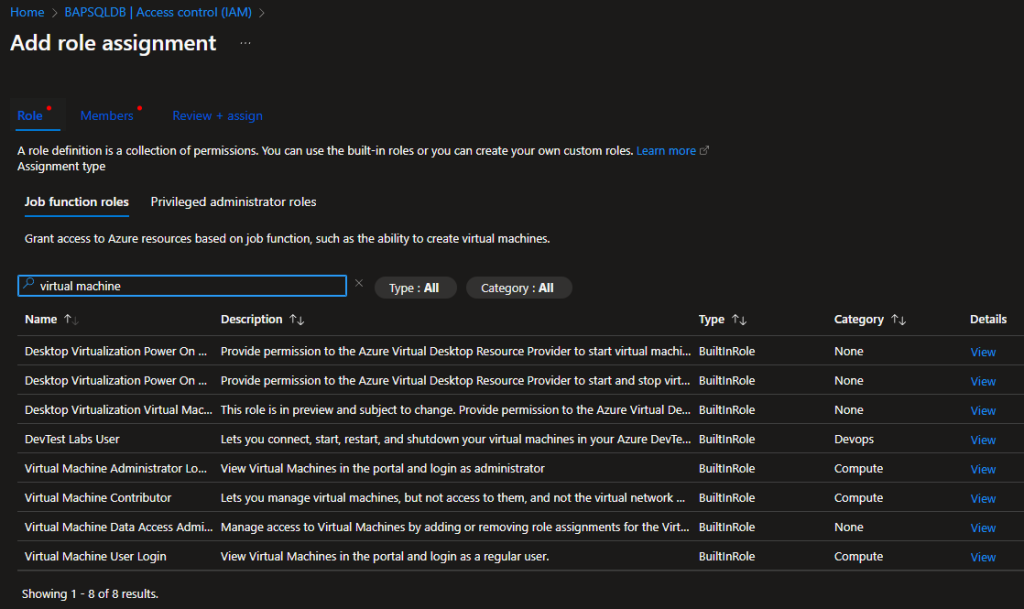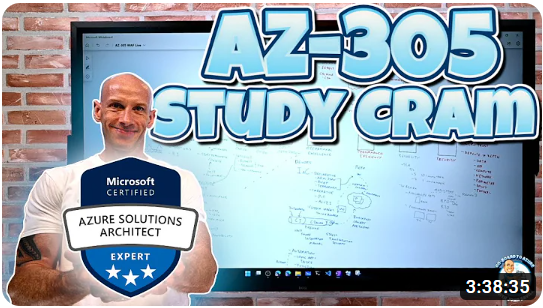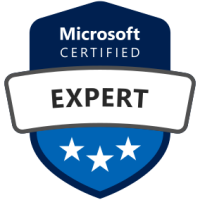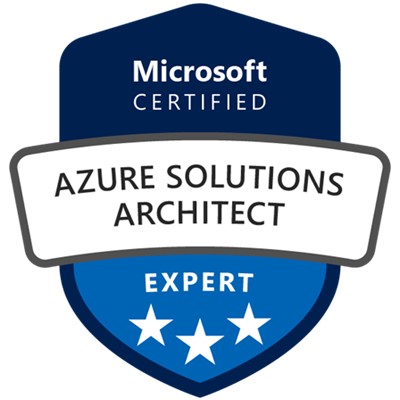Widely accepted as the pinnacle of Azure Certifications, many choose to aim for the Azure solutions architect certification after completing several fundamentals and associate level certifications in the Azure space. It is an expert level certification and covers the architecture design of cloud computing in Azure. Whilst one of the required exams is relates to administration, the principal of an architect is in the planning of the infrastructure and choosing best services for a given workload, factoring in customer and regulatory requirements.
Let’s look at this certification in more detail.
Who is this certification for?
Being an expert level certification, it would assume some knowledge and experience in IT already, and more specifically in the Azure cloud environment. You could be gaining knowledge through learning, through practice or a combination of the two. Someone who is in an Azure administrator or helpdesk role may consider this certification to move up into becoming a cloud architect. A cloud architect, specifically an Azure cloud architect will help organisations transitioning to the cloud or improve existing cloud assets by rearchitecting into cloud native solutions, potentially adding ability to scale and/or design redundancy into their applications.

Internally at Microsoft, there are Azure customer success managers (CSMs), who can move into a Azure cloud solution architect (CSA) role, and obtaining this certification is highly advantageous for the CSA position, or potentially join the company as a CSA if Microsoft are recruiting externally. Azure has many partners and end user customers, many of them who will be recruiting for cloud architects.
Exam requirements
Previously, this certification was achieved by passing two exams one regarding the technology and one regarding the design – AZ-303 and AZ-304 were the last iterations of this format. Now, we find there are still two exams to pass but one is a certification in itself and it is likely already in many Azure professional’s portfolio, the AZ-104, Microsoft Azure Administrator. The other exam is the AZ-305, Microsoft Azure Architect Design. You can take the exams in either order but the Microsoft Certified: Azure Solutions Architect Expert certification is not awarded until both exams have been passed.
The certification is valid for 1 year and you can revalidate your certification to extend year on year by passing an assessment. You can take the assessment 180 days before expiry right up to the expiry date. You don’t have to renew the Azure administrator certification to keep the Azure architect certification, but it would be nice to think you would renew all the certifications as they become eligible to do so.
In a previous blog post, we have gone through the AZ-104 exam and related certification, so in this post we will cover the AZ-305.
Topics covered
If we follow along Microsoft’s own learning path material, starting with a perquisite set of modules they provide, which includes core architectural components of Azure, describing compute, networking and storage services. There is a module on identity, access and security and another on the Microsoft cloud adoption framework for Azure. The prerequisites modules conclude with an introduction to the Microsoft Azure well-architected framework. Depending on your experience and how recently you have covered these areas will determine if you want to work through these or not. Now, let’s continue with the actual modules that are part of the AZ-305 and should cover the skills measured.

The first learning path is titled design identity, governance, and monitor solutions. Most of this should be familiar to those who have already completed the Azure administrator certification. The first module in this learning path is design governance, which deals with the management group > subscription > resource group hierarchy as well as tags, policies, role-based access control (RBAC) and landing zones. This is followed by design authentication and authorization solutions, which is very Entra ID heavy, including business-to-business (b2b), business-to-consumer (b2c), conditional access, identity protection, access reviews, service principals and managed identities. There is also a section on Azure key vault. The last module in this learning path is design a solution to log and monitor Azure resources, which covers Azure monitor, log analytics workspace and Azure Data Explorer.
Next learning path in the series is the design business continuity solutions, which covers describe high availability (HA) and disaster recovery (DR) strategies module, which includes HA and DR for PaaS and IaaS resources, Recovery Time Objective (RTO), Recovery Point Objective (RPO) considerations, and what to plan for in hybrid (cloud and on prem) scenarios. The other module in this learning path is design a solution for backup and disaster recovery which focuses on Azure backup, specifically for Azure blob, Azure files, Azure virtual machine, Azure SQL backup and recovery. Lastly for this module, designing for Azure site recovery is included.
The third AZ-305 learning path is design data storage solutions which begins with a module on designing a data storage solution for non-relational data. This will be all things storage accounts and specifically blob storage and Azure files. Also covered are Azure managed disks, data redundancy and storage security. The next module is not surprisingly design a data storage solution for relational data, covering Azure SQL database, Azure SQL managed instance, SQL Server on Azure virtual machines and Azure SQL edge. Items you are asked to consider include database scalability, availability and security for data in rest, in transit and in use. To conclude the module, we have table storage and the Cosmos DB Table API. The third and final storage solutions module is design data integration where the candidate will be asked to consider solutions that involve Azure data factory, Azure data lake, Azure databricks, Azure synapse analytics and Azure stream analytics. An important part of this data integration section is designing strategies for hot, warm, and cold data paths.

The largest section in the skills measured, some 30-35% of the exam score is designing infrastructure solutions and so we will go through what is required in this subject area now. The first module is design an Azure compute solution and covers a large number of Azure compute services including virtual machines, Azure batch, Azure app service, Azure container instances (ACI), Azure Kubernetes service (AKS), Azure functions and Azure logic apps. Choosing the right compute service is a key part of cloud architecture so it is important to have these down pat. Next is design an application architecture, which mostly covers Azure event and messaging solutions, namely Azure queue storage, Azure service bus, Azure event hubs, and Azure event grid. There is a section on designing an automated app deployment solution using ARM templates or BICEP. Also covered in the apps section is Azure Cache for Redis, Azure API management and Azure app configuration. The number of components mentioned in the design network solutions learning path is considerable. It begins with general networking considerations, thinking about IP addressing, selecting a region, and choosing a topology; hub-and-spoke is the most popular so expect this to be featured in the exam. Azure virtual network NAT and route tables (system and user defined routes (UDR) are included also. The section in the module on on-premises connectivity to Azure virtual networks expects a knowledge of when to use Azure VPN Gateway or Azure ExpressRoute (with optional VPN failover) and when Azure virtual WAN maybe appropriate. Staying with networking, a section is dedicated to application delivery services, which mainly deals with load balancing solutions, namely Azure Front Door, Azure Traffic Manager, Azure Load Balancer and Azure Application Gateway. You are expected to know when to use a given solution depending on regional or global requirement, working on OSI layer 4 or 7 and if the workload is internal or public facing. Also you should know when to use the Azure Content Delivery Network (CDN). Then to wrap up networking there’s the section on designing application protection services which again contains a lot of services including Azure DDoS Protection, Azure Private Link, Azure Web Application Firewall, Azure Firewall, virtual network security groups (NSGs), Service endpoints, Azure Bastion and JIT network access. Design migrations is the final module of the infrastructure learning path. It begins with understanding the Azure migration framework as part of the wider Cloud Adoption Framework. This module then develops into leveraging tools that assist with the migration journey, including Service Map, Azure Total Cost of Ownership (TCO) Calculator, Azure Migrate, Data Migration Assistant (DMA), Database Migration Service, Azure Cosmos DB Data Migration tool and Azure Resource Mover. The migration section concludes with the various methods to get data in and out of Azure. Azure Storage Migration Service, Azure File Sync, Azure Import/Export service, AzCopy, Azure Storage Explorer and Azure Data Box are are services that are used to migrate your data. That is a lot but remember, this is design, so you won’t be going into these services in any great detail, only knowing when to use a solution for a given scenario.
The penultimate learning path for the AZ-305 exam is build great solutions with the Microsoft Azure Well-Architected Framework. This is an established process to follow to give a project in the cloud a great chance of success. The Microsoft Azure Well-Architected Framework consists of five pillars:
- Cost optimization
- Operational excellence
- Performance efficiency
- Reliability
- Security
Each of these pillars will be understood by the candidate to ensure the opportunity to architect a solution has these important factors taken into account. To help with learning, each pillar has it’s own module within the learning path.

The final learning path is accelerate cloud adoption with the Microsoft Cloud Adoption Framework for Azure. The concept here is to understand the goals, evaluate the project from an IT, financial and operational perspective and bring along stakeholders to champion the cloud adoption through it’s various stages. There is a whole module on using Azure landing zones to support your requirements for cloud operations as well as other modules on migration best practice, building in resilience and designing with security in mind. As part of the adoption journey, there needs to be consideration regarding minimum viable product and measuring project effectiveness and what success looks like.
Exam hints and tips
The first advice whether seasoned in Azure or not would be to complete the fundamentals and administrator certs before attempting this exam. There is a fair bit of crossover and keeping the broad topics fresh is a good way to build up to the more complex concepts. Also, if possible, try not to leave too much of a gap between taking them. Keeping the momentum going is a good way of not forgetting things already learned.
In many Azure certifications, it is often recommended to have hands on practice with the different types of resources as well as learning the theory. The design infrastructure solutions exam however is just that, design. The implementation comes in the administrator exam so this one is much more high level and plays to describing best practice solutions, not the nuts and bolts of creating a resource and so forth. In a way, this exam has a lot in common with the Azure fundamentals exam – although of course it is markedly more difficult.

Life is busy and this is a big exam and a big deal for your career and professional recognition. As such, if you can, reserve more time for study just before exam date, so you can have a bulk of recently stored knowledge to walk into the exam with. Make provisions with home and/or work to have more time to give yourself a last push, but keep it balanced. After several hours a day, it will become counter-productive to try to endure even more learning. Also don’t cram on the day of the test. By then the adrenaline will be blocking the ability to properly concentrate. My advice is also, don’t book the exam for the evening unless you are generally asleep in the daytime. These exams are long and take stamina. Early to mid-afternoon works well for me.
It’s always worth booking the exam before you are fully ready, to try and set a learning pace. If it gets close to the date and you feel are still miles off, you can reschedule (or even cancel for a refund), so long as it is more than 24 hours before the exam start time. A lot of these exams is down to confidence, if you aren’t sure if you’ll pass or not, give it a go anyway. If you don’t pass as least you will have some understanding on how far off the pass mark you are and what troubled you the most, so you can pass on the next attempt. I have often practiced with a real exam in this way, sometimes I pass to my surprise, sometimes not, and that is ok also.
There is more exam advice, much of which applies to this certification as well on the Azure administrator and Azure fundamentals posts.
Recommended resources
This section is going to seem like a stuck record if you have read the AZ-900 and AZ-104 posts, but it has to be said, regardless of what 3rd party resources you decide to assist with your learning, you should consume the official Microsoft AZ-305 exam learning paths. It is curated to cover all aspects of the skills measured, so if its not on this content, its unlikely to be on the exam. There are some exercises in the prerequisite modules but the rest of the learning path is information only (being a design, not administrator exam, that makes sense, right?)
John Savill must be mentioned again. As discussed in previous posts, John’s YouTube content equals or surpasses much of the commercially available courses out there. Not only John gives up his free time to produce this huge body of work, he refuses to monetise his YouTube channel, so you don’t even see ads! For this exam John provides an entire playlist of videos relevant to the exam including his hugely popular AZ-305 study cram.

Beyond those two free resources, there is plenty of other free material online as well as many popular websites such as Pluralsight, Udemy, LinkedIn Learning and Cloud Academy offering a dedicated AZ-305 course. I haven’t reviewed any of these so cannot comment on their quality, so check out what is on offer with any paid subscriptions you already have or ask others who have recently certified what courses they used.
Next steps
Once you have achieved the Microsoft Certified: Azure solutions architect expert certification, you really do have so many options on what to choose next, we could almost list every Azure certification here. What you do next in terms of certification will depend a lot on your strengths, your interests and perhaps some influencing factors such as encouragement by your current employer to follow a certain path that is compatible with a skill shortage they have identified. Or perhaps you have been reading articles in the IT industry press about an overall shortage of skilled people in a certain IT category and you think a good career move would be to be qualified in that area of expertise.
Now you have one expert level certification, there are a couple of others in the Azure space – DevOps engineer expert & Cybersecurity architect expert, both of which require a couple of exams to get the qualification, but in some cases, you may already have one of these when working towards other goals. For example, the AZ-104 is one of the two exams required for the Azure solutions architect expert exam, but it also can be used along with the AZ-400 to obtain the DevOps engineer expert certification.
There are plenty of associate level certifications in all sorts of areas of Azure cloud such as data engineering, networking, security, AI, Developer and so on. There are also speciality certifications in subjects such as Cosmos DB, Azure virtual desktop and Azure for SAP workloads.


Leave a Reply